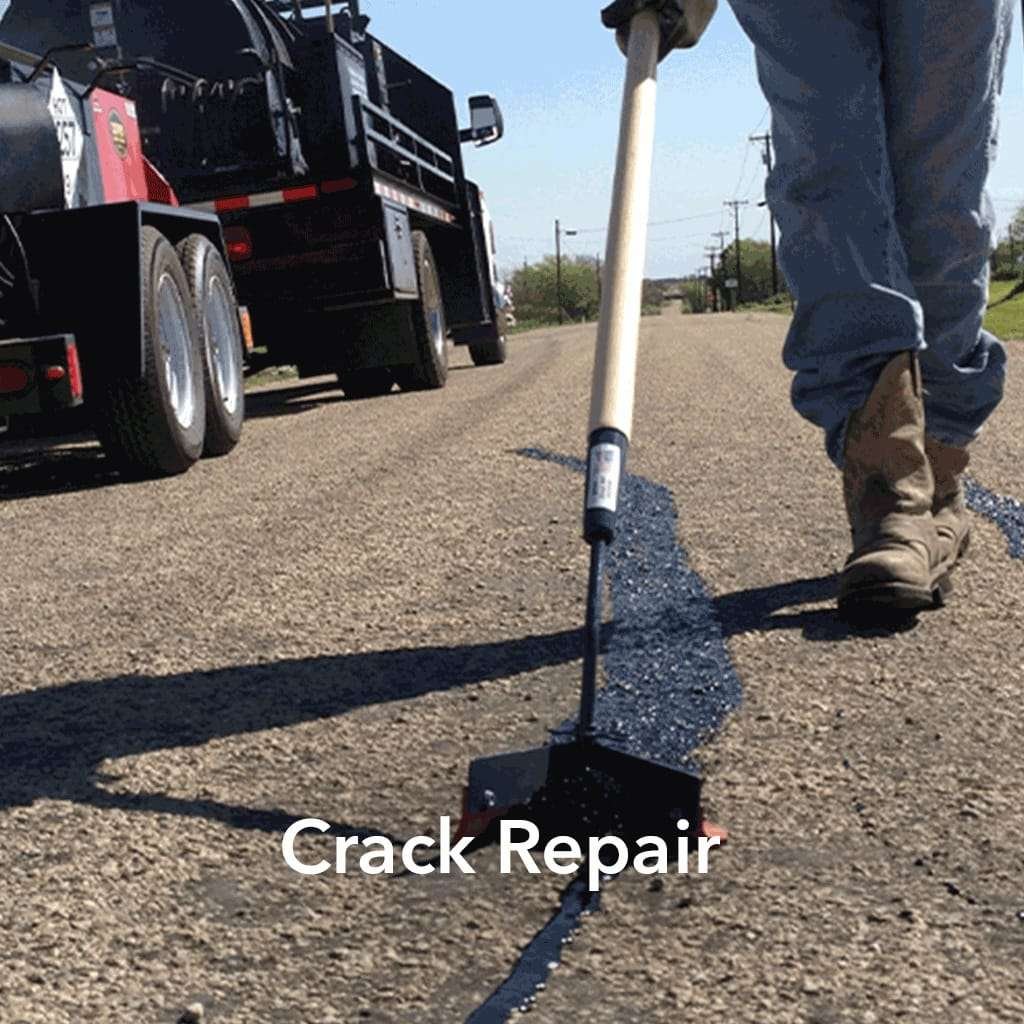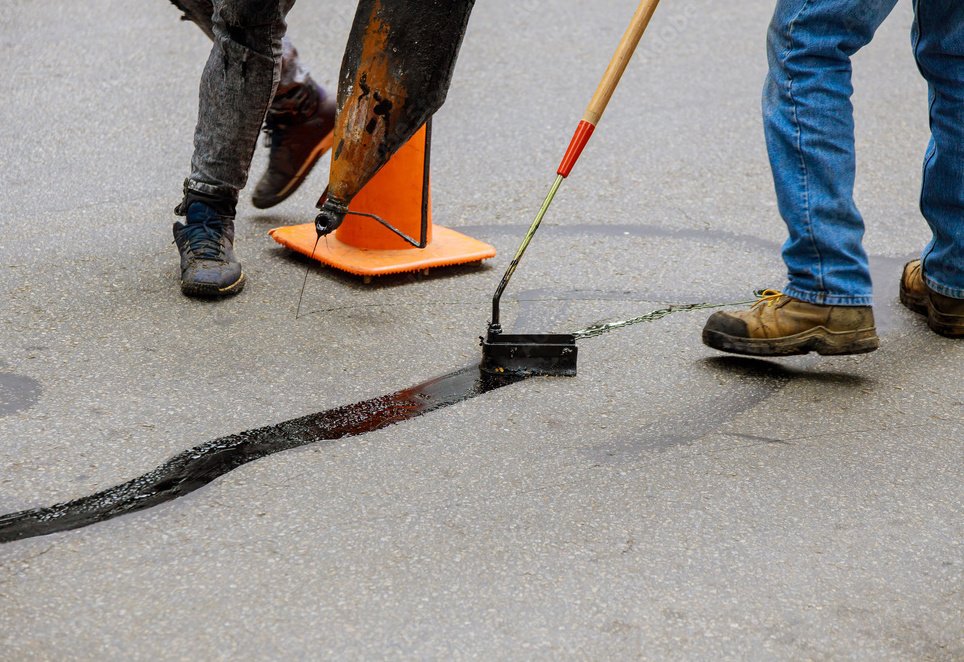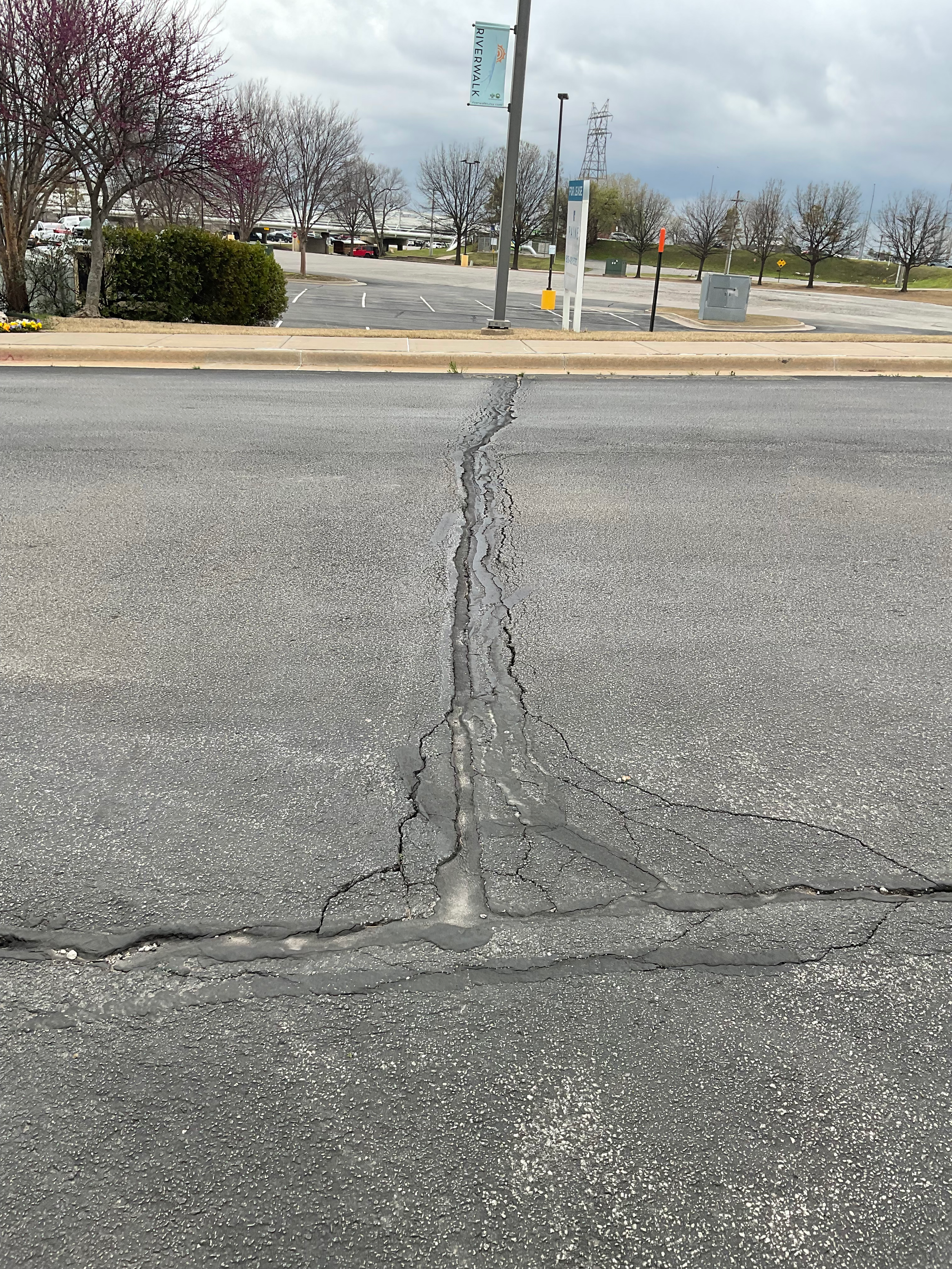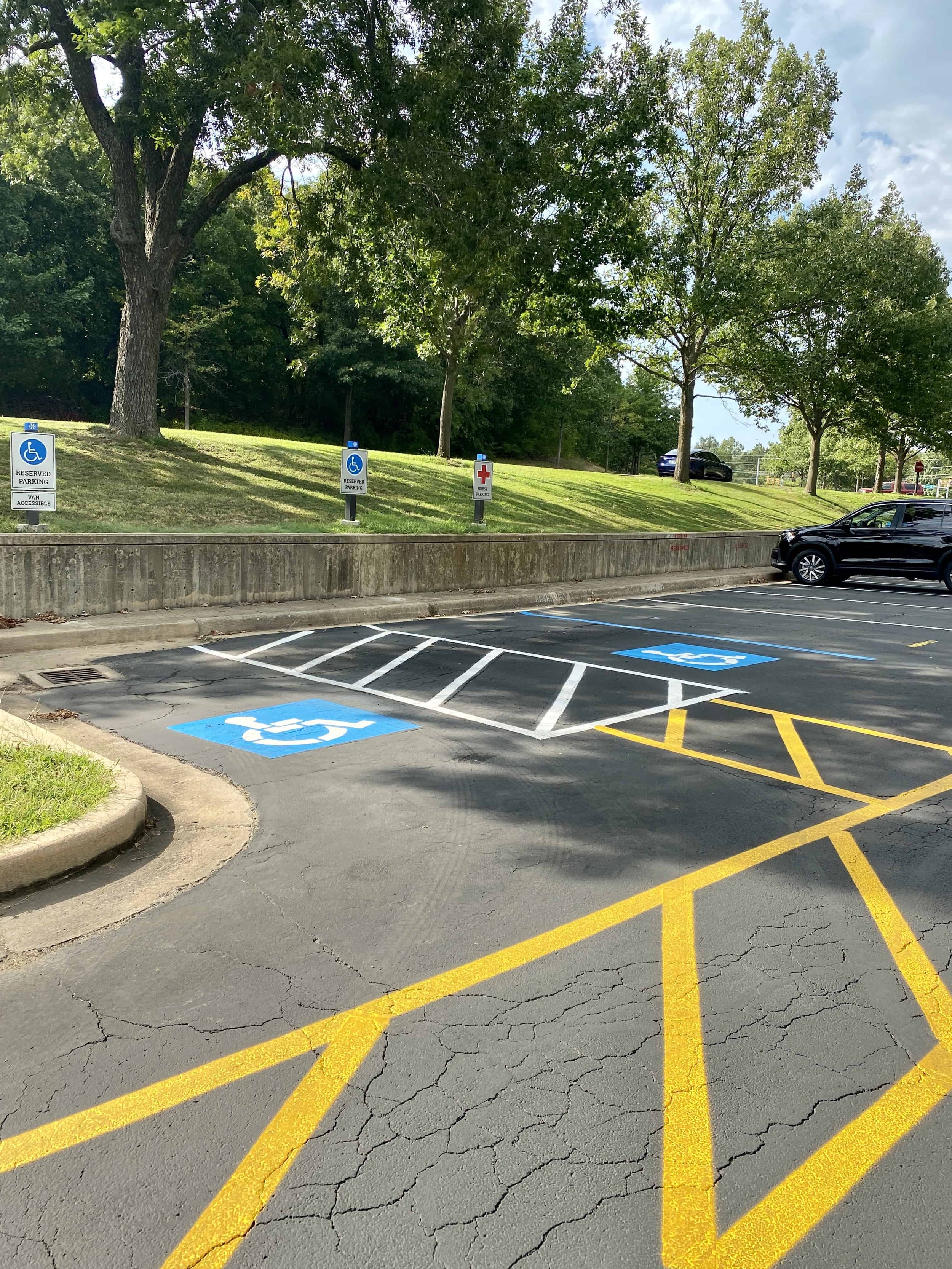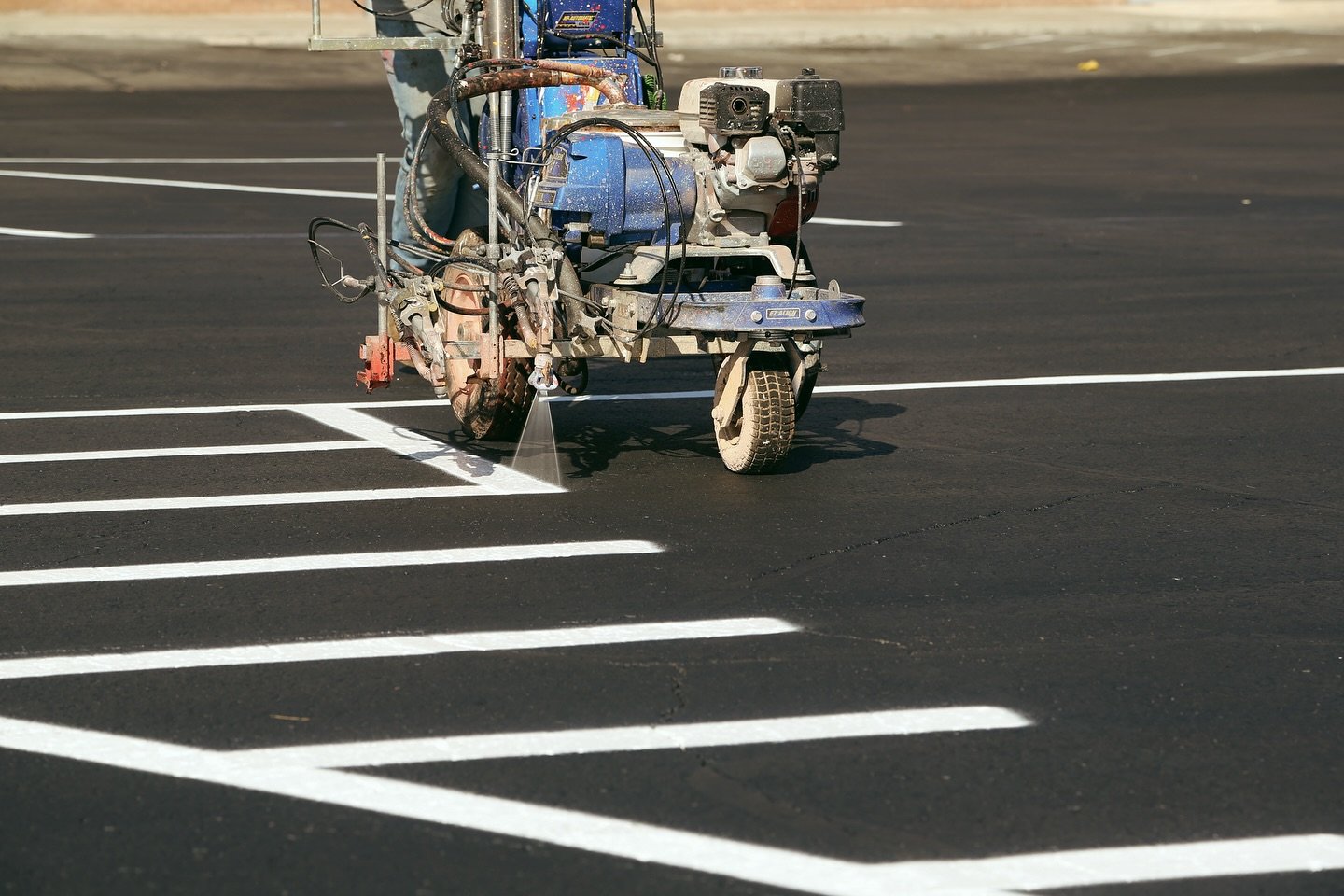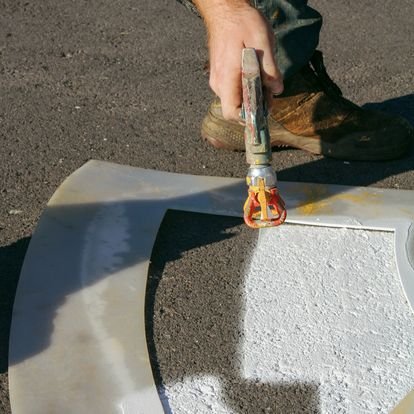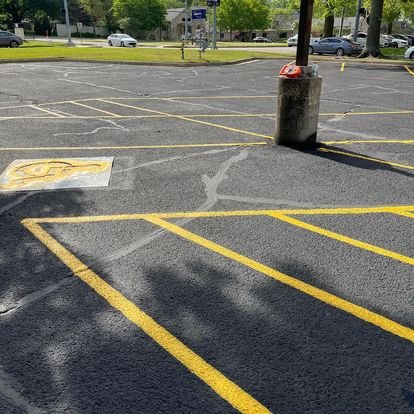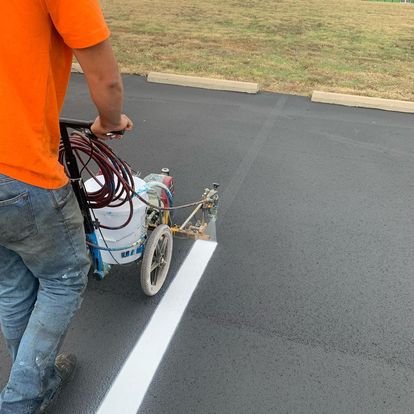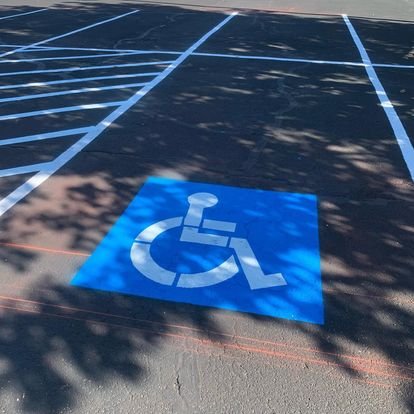The Ultimate Guide to Asphalt and Pavement Patching: Everything You Need to Know!
Maintaining your driveway, parking lot, or pavement in good shape requires essential asphalt and concrete patching. Over time, weather and traffic can cause cracks and potholes in roads. These can be both unsightly and hazardous.
That's where patching comes in. Patching up your driveway or pavement keeps it safe, smooth, and looking good. In this guide, we'll answer all your questions about asphalt and concrete patching so that you can make the best decision for your project.
This post will tell you all about how to fix your pavement, including basic patching, various techniques, and the benefits. We'll walk you through the entire process, explain how various patching methods work, and highlight the pros and cons of each.
Let's get started!
What's Patching?
Patching is the process of repairing small holes, cracks, or damaged surfaces on asphalt or concrete. Over time, these surfaces take a beating from traffic, weather, and other factors, which can lead to potholes, cracks, and other damage. Patching is like laying a new parking lot over the bad areas, while keeping the good areas. It helps extend the life of your pavement, improve safety, and maintain a clean, attractive appearance.
Types of Patching Materials
Asphalt
Ideal for repairing asphalt surfaces, it adheres well to existing pavement in the case of overlays. It also provides a durable finish, and is the equivalent of a new parking lot if installed correctly. This is made up of lots of rocks and sand heated up and covered in oil. As the oil cools and the rocks are compacted together it creates a durable surface.
Concrete
Best for repairing concrete surfaces like parking lot aprons and sidewalks. Concrete is made up of special sand, cement, and other rocks. Usually poured as a thick viscous liquid. When this is laid, it’s the equivalent of a new parking lot.
Other Repair Compounds
Epoxy, polyurethane, and other specialty materials for specific repairs. There are so many options in this category and these are done for very unique and special instances.
How Does It Work?
Before diving into the specific patching techniques, it's important to understand the overall process. Asphalt patching involves several steps. First, we locate damaged areas.
Then, we remove damaged areas, and clean and prepare the subase. Next, we fill the damaged areas with new asphalt patching material. Finally, we compact the material to make the patch.
Asphalt Overlay or Surface Patching
Adds a layer of hot asphalt over the pre-existing surface. Ideal for badly cracked asphalt but not crumbling areas. We use a bonding agent (Tack Coat) for adhesion. A temporary fix that can last between 5 and 15 years depending on the existing surface and overlay thickness.
Partial Patching
Grinds off the top 2-3 inches of asphalt and replaces it with new, compacted material. We seal the edges for better durability. This method works well when damage is only in the surface layer and there is still a good base layer
Removal & Replacement Patching
Fully removes damaged asphalt down to the sub-base, then compacts and levels the base before applying a new layer of asphalt. A permanent fix but more costly.This is the best way to replace existing bad parking lot sections and address the root cause problems.
Hot vs. Cold Asphalt Patching
For asphalt patching, you have two primary options: hot asphalt and cold patch. The choice between them largely depends on the size of the repair, budget, and weather conditions. Let's break down the key differences:
Cold Patch: Ready-to-use, does not need heating, and you can pour it straight into potholes or cracks. A quick fix but considered temporary.
Hot Asphalt: Durable and long-lasting but requires skilled workers and can only be applied in warm weather. Takes around 24 hours to cure.
How Does an Asphalt Patch Work?
Asphalt patching fixes damaged asphalt by adding new material on top of existing material or or removing existing material and reapplying it. . Here's a quick breakdown of our process:
Identifying the Damaged Area:
Inspect the pavement to find potholes, cracks, or deteriorated sections needing repair.
Removing, Cleaning, and Preparing the Surface:
We go through and create clean saw-cut lines around a patch.
We remove the damaged areas of debris and vegetation.
Square off the edges to ensure proper bonding when new material is installed
Filling and Compacting the Patch Material:
Cold Patch: Pour ready-to-use cold mix into the hole and compact it layer by layer.
Hot Mix Asphalt: Apply heated asphalt in layers and compact each layer with a roller.
Allowing the Patch to Cure:
Cold Patch: Cures as it hardens with air exposure and typically takes 24-48 hours.
Hot Mix Asphalt: Takes around 24 hours to be drivable and 72 hours more fully cure.
What Are the Benefits of Asphalt Patching?
Asphalt patching is a smart, cost-effective solution to keep your pavement in top condition. Instead of removing your whole parking lot and replacing it, patching allows us to remove the bad sections, install new parking lot, and give you a long lasting surface. Patching your asphalt can help fix potholes, cracks, and surface damage, making it last longer and keeping it safe and smooth. Here's a quick overview of the key benefits:
Benefits Overview:
Cost-Effectiveness:
Patching is much cheaper than resurfacing or replacing an entire pavement.
By repairing small areas early, you prevent the need for more extensive and expensive repairs down the road.
Improved Safety:
Filling potholes and cracks reduces the risk of accidents and injuries.
Creates a safer environment for both vehicles and pedestrians.
Longevity of Surface Life:
Regular patching prevents further deterioration of the asphalt surface.
Helps maintain the pavement's structural integrity, extending its overall lifespan.
Aesthetic Appeal:
Patching improves the visual appeal of your driveway, parking lot, or roadway.
A well-maintained surface enhances the overall look of your property.
How Long Does It Take for an Asphalt Patch to Cure?
Curing is the process where the patch material hardens and bonds with the surrounding pavement, creating a durable repair. The time it takes for an asphalt patch to cure depends on several factors:
Cure Time Factors:
Temperature and Weather Conditions:
Warm Weather: Accelerates curing, especially with hot mix asphalt.
Cold Weather: Slows down the curing process, particularly for cold patch material.
Moisture: Rain or high humidity can delay curing.
Patch Material Type:
Cold Patch: Ready-to-use, air-cured material. Takes longer to cure than hot mix.
Hot Mix Asphalt: Requires heating, compacts firmly, and cures quickly.
Traffic Load on the Surface:
High Traffic: Increases compaction but can slow curing if the patch isn’t fully set.
Low Traffic: Allows proper curing with minimal disturbance.
General Patch Cure Time Guidelines:
Cold Patch:
Cures as it hardens with air exposure
Typically takes 24-48 hours to cure
Hot Patch:
Compacted with specialized equipment
Takes around 1-2 hours to cure fully, allowing traffic soon after
Tips for Faster Patch Curing:
Ensure proper compaction of the patch material
Avoid patching during wet weather if possible
For cold patch, use a vibratory tamper or plate compactor for better results
How Long Does Asphalt Patch Take to Dry?
The drying time for an asphalt patch refers to the period it takes for the surface to become hard enough for light traffic, also called cure-time. Understanding the difference between drying and curing in asphalt patching is important.
Difference Between Asphalt Patch Drying and Curing:
Asphalt Patch Drying:
Refers to the surface-level hardness of the patch material.
Allows for light traffic but doesn’t guarantee full structural stability.
Asphalt Patch Curing:
Involves complete hardening and bonding of the patch with the surrounding asphalt.
Ensures the patch can withstand regular traffic and environmental stress.
Drying Time Guidelines:
Cold Patch:
Ready-to-use and air-cured
Typically takes 1-2 hours to dry for light traffic
Hot Patch:
Compacted using specialized equipment
Takes around 30 minutes to 1 hour to dry sufficiently for light traffic
Expert Note:
Even after drying, you should avoid heavy traffic until the patch fully cures for maximum durability.
What Are the Methods of Asphalt Repair?
Repairing asphalt depends on the type and extent of the damage. Here’s a rundown of the most common asphalt repair methods:
Pothole Repair:
Description: Filling potholes with cold or hot mix asphalt patch material.
Process:
Clean and square off the edges of the pothole.
Fill the hole with patch material in layers.
Compact each layer firmly to ensure a durable bond.
Best For: Quick fixes to improve safety and prevent further deterioration.
Crack Sealing:
Description: Applying hot or cold sealant to small cracks in the pavement.
Process:
Clean the cracks thoroughly to remove debris.
Pour or inject the crack filler material into the crack.
Smooth the surface using a squeegee or other tool.
Best For: Preventing moisture infiltration and further crack growth.
Overlaying:
Description: Adding a new layer of asphalt over the existing surface.
Process:
Clean and prepare the existing pavement surface.
Apply a tack coat to enhance adhesion.
Lay down a new asphalt layer, typically 1-2 inches thick.
Compact the new layer with a roller for a smooth finish.
Best For: Extending pavement life and improving appearance.
Full-Depth Repair:
Description: Removing damaged sections and replacing them with new material.
Process:
Cut and remove the damaged asphalt down to the sub-base.
Repair or replace the sub-base if needed.
Lay down and compact new asphalt layers.
Seal the edges to prevent moisture infiltration.
Best For: Severe structural damage or large, deep potholes.
Edge Repair:
Description: Addressing broken or crumbling pavement edges.
Process:
Cut back the damaged edges to create a clean line.
Fill and compact with new asphalt or concrete mix.
Seal the edges to prevent moisture infiltration.
Best For: Restoring the integrity and safety of the pavement edges.
Each of these methods plays a vital role in keeping your asphalt surfaces safe, attractive, and long-lasting. Make sure to choose the right repair approach based on the condition of your pavement and your specific needs.
Can You Use Asphalt Patch on Concrete?
Yes you can. Using asphalt patch on concrete is usually temporary. Making proper concrete repairs is best for a more permanent solution.
Feasibility:
Using asphalt patch on concrete is not always ideal because of the different material properties.
Cold patch asphalt may not bond as well to concrete as it does to existing asphalt.
Suitability:
Small Cracks or Holes:
Can be effective as a temporary solution.
Provides a quick fix to prevent further deterioration.
Large Cracks or Structural Damage:
Not recommended because of the poor bond between asphalt and concrete.
Concrete-specific patching material or repair compounds are better suited for this type of damage.
Asphalt Patching Techniques
Various techniques can repair asphalt, depending on the type and extent of the damage. Here’s an overview of the most common asphalt patching techniques:
Throw-and-Go:
Description:
A quick fix for potholes and small cracks.
Involves filling the hole with cold patch material and leaving it without additional compaction.
Benefits:
Fast and easy application.
Drawbacks:
A temporary solution that may not withstand heavy traffic.
Throw-and-Roll:
Description:
Similar to throw-and-go, but involves compacting the patch material with a roller or tamper.
Improves the bond between the patch material and surrounding asphalt.
Benefits:
Provides increased longevity compared to throw-and-go.
Drawbacks:
Still considered a temporary fix.
Semi-Permanent:
Description:
Involves cutting around the damaged area to create straight edges.
Cleaning the hole of debris, filling with hot or cold patch material, and compacting with a roller.
Benefits:
Provides a more durable and long-lasting repair.
Drawbacks:
Requires more time and effort than throw-and-go or throw-and-roll.
Infrared Repair:
Description:
Heats the damaged asphalt area using infrared technology.
Softens the existing asphalt, allowing it to blend with new patch material.
Benefits:
Seamlessly blends old and new asphalt for a smooth finish.
Environmentally friendly as it recycles existing material.
Drawbacks:
Requires specialized equipment and trained operators.
Each technique has its advantages and limitations. Selecting the right patching method depends on the damage severity, budget, and desired repair longevity.
What Factors Influence Patch Durability?
Several factors can impact the longevity and durability of your asphalt patch. Here's what you should keep in mind:
Surface Preparation:
Proper cleaning and preparation of the damaged area are crucial.
Remove debris, vegetation, and loose material to ensure a strong bond.
Patch Material Quality:
High-quality asphalt mix (hot or cold) provides better adhesion and durability.
Make sure the patch material is suitable for the specific repair type.
Compaction:
Proper compaction of the patch material ensures structural stability.
Use appropriate equipment (roller, tamper, vibrating plate) for optimal results.
Weather Conditions:
Extreme temperatures (hot or cold) can affect patch curing and bonding.
Avoid patching in wet conditions to prevent moisture infiltration.
Traffic Load:
High traffic loads can accelerate wear and tear on the patch.
Allow sufficient curing time before exposing the patch to heavy traffic.
Sealcoating:
Applying a sealcoat after curing protects the patch from moisture and UV damage.
Ensure proper weather conditions for effective sealcoating.
What Maintenance Should Be Done After Patching?
Maintaining your asphalt patch ensures its longevity and keeps your pavement looking great. Here’s what you should do:
Regular Inspections:
Conduct routine inspections to spot new cracks or potholes early.
Check the patched area for signs of wear, settling, or moisture infiltration.
Crack Sealing:
Seal any new cracks that appear around the patched area.
Use a hot or cold crack filler to prevent further deterioration.
Sealcoating:
Apply a fresh sealcoat over the patched area after curing.
Repeat sealcoating every 2-3 years for maximum protection.
Keep the Surface Clean:
Sweep or wash away debris, dirt, and vegetation regularly.
Prevent oil and chemical spills from damaging the asphalt.
Limit Heavy Traffic:
Avoid parking heavy machinery or vehicles on the patched area.
Redirect traffic during extreme weather conditions to reduce wear.
How Regional Groundwork Can Help with Your Asphalt or Pavement Patching/Repair in Tulsa, OK
Regional Groundwork is the best choice for reliable and professional asphalt patching and repair services. Trust us for all your needs.
Services Offered:
Within our Asphalt Patching/Repair Services, we include:
Comprehensive Inspection, customized repair Solutions, use of advanced techniques, high-quality materials and affordable and timely services.
Don't let damaged pavement affect the safety and appearance of your property. Contact Regional Groundwork today for a comprehensive inspection and a customized repair solution. Get a free consultation today!
What is Crack Filling - All You Need to Know
Crack filling is a crucial aspect of maintaining the health and longevity of pavement. This blog post will help you understand crack filling better. The discussion will cover why they form, why maintenance is important, how to do it, and when you should do it.
Knowing about crack filling can help you protect your investment and keep surfaces safe and smooth.
What is Crack Filling?
Crack filling is a common service for maintaining pavement. It helps prevent water and debris from seeping into the base layers of asphalt. This is arguably the most important maintenance activitiy someone can do for their parking lot. Not filling cracks causes significant pavement deterioration over time.
This process involves filling cracks in the pavement with hot or cold filler material. The purpose is to seal the cracks and reduce the water that gets into it. The cracks must be completely dry for this process to be effective.
Many people confuse crack sealing with crack filling, but they are actually the same. The goal is to seal/fill the crack and reduce the water that can access the subbase.
What Are the Different Types of Pavement Cracks?
Two main types of pavement cracks exist: shrinkage cracks and overloaded/failure cracks. Each type needs a different repair approach based on how they behave.
Shrinkage Cracks:
Shrinkage cracks form whenever the pavement needs to release shrinkage stress. This is a fancy way of saying when the asphalt gets cold and shrinks a crack will naturally form. Asphalt is just rocks held together by a special oil. Asphalt doesn’t have rebar in it like concrete, so when it needs to crack, there is nothing holding it together like concrete.
Asphalt shrinkage crack being filled
These cracks continue to grow over time and need to be filled to prevent water from getting into the subbase. That is where a reliable asphalt maintenance company will come into play. They will come in, fill the cracks and significantly reduce the water getting to the subbase.
Overload or Failure Cracks:
These cracks often form something called alligator cracking. This is where the asphalt looks like the back of an alligator. When this happens there is usually an underlying problem in the subbase, the thickness of the asphalt, or the compaction of the asphalt. Generally, the safest fix for this is patching. There are some ways to fill the cracks temporarily to reduce how fast the alligator cracking grows.
This blog post is not focused on this type of cracking. Take a look at our patching blog post for more information here.
Asphalt alligator cracking
What Materials Are Used in Crack Filling?
There is really only one material that’s stood the test of time for crack filling. It’s a polymer modified rubberized asphalt. There are cold options available, but are difficult to apply, and do not expand or contract well. We don’t ever recommend that type of crack filler. We exclusively use the rubberized crack sealant and recommend anyone having work done to do the same.
What Is The Process of Crack Filling?
The crack filling process is a critical maintenance technique to ensure longevity and safety of pavement surfaces. This process typically involves four key steps: cleaning, heating, filling, and smoothing. Let's explore each step in detail:
1. Cleaning: The worker must clean the crack thoroughly to ensure the filler material adheres properly. This is done in several ways, but there cannot be dirt or water in the crack.
2. Heating: Hot-pour fillers heat the material to a liquid state before application.
3. Filling: The worker applies the filler material into the cleaned crack using a pour pot, or a wand.
What Are the Benefits of Crack Filling?
Crack filling is a preventative maintenance technique that offers significant benefits for pavement preservation. Here are the key advantages of implementing crack filling in pavement management:
Extends Pavement Life:
One of the primary benefits of crack filling is its ability to extend the life of pavement surfaces. By effectively sealing cracks, it prevents water and other harmful substances from penetrating the base layer of the asphalt. This protection strengthens the pavement and prevents the need for expensive repairs too soon.
Cost-Effective:
Compared to more extensive repair methods such as full pavement replacements, crack filling is a much more economical option. This method helps pavement last longer by using less material and labor. As a result, we can delay expensive pavement replacements. A cost-effective solution for long-term pavement maintenance.
When to Opt for Crack Filling
Perform crack filling as soon as you detect cracks and before they expand significantly. Early intervention prevents water infiltration that can lead to more severe asphalt damage and higher repair costs.
The traditional industry standard is seal and crack fill every 3-5 years depending on vehicle traffic. Regional Groundwork philosophy is crack fill yearly and seal when the light gray of the asphalt is showing. This protects your subbase and your surface whenever it’s needed.
What Are the Signs That Crack Filling is Needed?
Visible cracks that are not filled.
Areas around cracks where more cracks are forming.
Cracks in areas near water drainage.
How Do You Choose a Crack Filling Service?
When selecting a crack filling service, look for:
Insured and reputable: Make sure the company has the proper insurance to protect against any potential liability and they have customers in your local area you can look at the parking lots of
Experienced Professionals: Choose a company with a proven track record and experienced technicians.
Do you need crack filling services in Greater Tulsa and Oklahoma City? We can help! We offer certified and professional services tailored to meet your needs.
What Are Common Follow-Up Treatments After Crack Filling?
After fixing cracks, it's important to provide maintenance. This will also help ensure the longevity of the pavement. Following these steps is crucial for the overall upkeep of the surface. Here are the common maintenance practices recommended post-crack filling:
Regular Inspection and Reapplication:
One of the most critical follow-up treatments is the regular inspection of treated areas for signs of wear. This helps in identifying any failures in the crack filler early on. Adding filler when needed can prevent small issues from turning into larger ones. This helps the repair last longer and maintains the pavement in good condition.
Keeping Cracks Clean:
Maintaining cleanliness in the treated cracks is also vital. Debris, dirt, and vegetation can accumulate in cracks over time, which may cause them to reopen or expand. Keeping the filler clean helps it stay in place and seals cracks well, stopping water from getting in and causing damage.
Sealcoating:
After crack filling, applying a sealcoat is a highly recommended treatment. Sealcoating protects filled cracks and the pavement surface from oxidation, wear, and UV rays. This helps the crack filling last longer and improves the pavement's durability and appearance.
Learn more about sealcoating and its benefits.
Periodic Re-evaluation:
Regular assessments by professional pavement maintenance teams are essential to monitor the condition of the repaired areas. These evaluations help identify any further deterioration or new damage early on.
After evaluating the situation, you can schedule repairs to maintain the pavement and prevent minor issues from escalating. This will keep the pavement in good condition. Addressing any necessary repairs promptly is important to avoid larger problems in the future.
FAQs
Understanding the specifics of crack filling can help property owners and managers make informed decisions about pavement maintenance. Here are answers to some of the most common questions regarding crack filling in asphalt:
-
Filling cracks in asphalt begins with thorough cleaning of the crack to remove debris and ensure a clean surface for adhesion. After cleaning, fill the crack with either an asphalt emulsion or a hot-applied sealant. The choice depends on the project's needs and the type of crack.
-
There isn’t a difference between the two.When we refer to crack filling the material specifically fills and seals cracks in asphalt pavements. The worker will apply it directly into the cracks to repair the damage and prevent further deterioration.
Sometimes people might think sealcoating asphalt is the crack as crack filling since they’re often done together. However, crack filling and sealcoating are two distinct operations under asphalt maintenance.
How Regional Groundwork Can Help with Your Crack Filling Needs
Regional Groundwork specializes in asphalt services in Greater Tulsa and Oklahoma City, delivering excellence with a commitment to safety, precision, and customer satisfaction. As experts in asphalt maintenance, we tailor solutions to address specific client needs, ensuring durable and long-lasting results.
Our experienced team prioritizes safety, enhancing both the functionality and aesthetics of parking lots and private pavements. By integrating our core values of accountability and stewardship, we not only repair but improve community infrastructure, contributing to safer and more reliable surfaces.
How Can I Make My Asphalt Last Longer?
Want to make your asphalt last longer? In this blog post, we share 8 easy tips to help you do just that. We'll cover everything from the basics of keeping your asphalt clean to the benefits of regular sealcoating. Whether you're taking care of a spacious parking lot or your home driveway, these tips will help you keep your asphalt in great shape for years to come.
8 Asphalt Maintenance Tips
1.Cleanup Debris or Spills Promptly
Low Spot that pools water and erodes subbase further
Maintaining a clean asphalt surface is not just about aesthetics—it's crucial for its longevity and functionality. A quick background, asphalt is just a bunch of rocks compacted together. Over time the rocks on the surface start to separate from slab and become loose gravel on the surface. This Debris acts like sandpaper and significantly accelerates the deterioration of your asphalt. As cars drive over the loose sand it will cause other sand and rocks in the slab to break loose. This can be seen in really old parking lots. As you walk around there are small sand piles all over the lot. This is the sand that comes up naturally over time. Moreover, spills, particularly oil, not only stain but can also weaken the asphalt, making it more susceptible to damage.
Importance of Immediate Cleanup to Prevent Surface Deterioration
Promptly removing debris and spills is crucial. If not taken care of, the oil and sand can damage the seal coat on asphalt, making it more susceptible to weather damage. Swift cleanup of oil and blowing off the lot at least quarterly helps avoid the deterioration of the surface, guaranteeing your asphalt stays smooth, secure, and aesthetically pleasing.
2.Drain Water Effectively
Good water drainage is crucial for asphalt surfaces to last long and stay strong. Understanding the role of proper drainage systems can prevent a myriad of issues that compromise asphalt's durability and functionality.
The Importance of Proper Asphalt Drainage
Standing water is the nemesis of asphalt driveways and pavements. It poses a significant threat to the structural integrity of these surfaces. When water pools, it seeps into small cracks, slowly breaking down the oils that hold asphalt together. Over time, this process can lead to the formation of cracks and potholes, degrading the pavement faster than its design life.
Worse than deteriorating oils, water can seep under asphalt and make the foundation shift or sink, causing serious structural issues. This is commonly how we get alligator cracking. The freeze-thaw cycle makes these problems worse. Water gets into the asphalt, freezes, and expands, causing more damage. Addressing standing water is vital for the long term health of your asphalt.
3.Fill Asphalt Cracks Immediately
Crack where water is eroding subbase and causing Alligatoring
Timely action is crucial for asphalt maintenance, particularly with crack filling. Small cracks can quickly evolve into significant problems if not addressed promptly. Here’s why immediate repair is necessary and how Regional Groundwork can assist:
Preventing Further Damage
Cracks in asphalt allow water and humidity to get into the pavement's subbase, causing more than just surface damage. Once moisture gets below the asphalt, it can cause widespread damage, starting with sinkholes and expanding into alligator cracking. Both are the precursor to the formation of potholes. Filling cracks early stops water damage and prevents more problems. This reduces the risk of further damage.
Don't let small cracks become significant problems. Contact an asphalt crack filling specialist, to protect and prolong the life of your pavement.
4.Investment in Quality Maintenance Materials
Choosing high-quality materials and committing to regular maintenance are foundational to the longevity and durability of asphalt surfaces. Let's explore why this investment matters and the role of a trusted contractor in this process.
The Necessity of High-Quality Materials
Asphalt, while durable, isn't immune to the wear and tear of environmental conditions. We’ve covered this multiple times now, exposure to the sun, rain, and changing temperatures can slowly damage surfaces in various climates over time.
Utilizing premium materials in the construction and repair of asphalt surfaces is essential to withstand these elements effectively. Choosing quality materials is primarily done by verifying the contractor isn’t changing the product you’re receiving from the manufacturer. Contractors applying materials should never be “cutting” material with water. They should be using the material exactly from the manufacturer and how the manufacturer recommends the application.
Regular Maintenance: Extending Lifespan
Routine maintenance is of utmost importance. It keeps the surface smooth and prevents damage by addressing issues before they become serious.
Small repairs and timely interventions, such as crack filling, sealcoating, and fixing low spots to improve proper drainage, are vital. These efforts help to prevent major distresses, extending the service life of your pavement considerably. Regular upkeep ensures your asphalt remains in optimal condition, safeguarding your investment and avoiding costly overhauls.
The Role of a Trusted Asphalt Contractor
Partnering with a reputable asphalt repair contractor is key to ensuring the quality and longevity of your pavement. A trusted contractor brings expertise, high-quality materials, and a commitment to excellence in maintenance practices. They can provide helpful advice on what your pavement needs, create custom maintenance plans, and make high-quality repairs.
5.Potholes: Address Them Early
Alligatoring turning into potholes since patching was not done earlier in asphalt life
Potholes are more than visually unappealing; they're a clear sign of deeper problems with asphalt surfaces and threat to vehicle safety. Understanding their impact and addressing them promptly is crucial for commercial property owners and local governments.
The Problem With Asphalt Potholes
When water collects in potholes and freezes, it exacerbates the damage, creating hazardous conditions for both drivers and pedestrians. The responsibility to maintain safe conditions in parking lots and roads falls heavily on property owners. Ignoring potholes not only risks the integrity of the asphalt but also the safety of those who use it.
Potholes start small but can get much bigger, ranging from basketball-sized to several feet wide as they grow over time. Large potholes can cause vehicles to jolt or even lose control, posing serious risks to drivers. Furthermore, potholes surrounded by extensive alligator cracking signal severe deterioration, indicating that without intervention, the asphalt may require complete replacement.
Early Intervention is Key
Addressing potholes at the first sign of damage is imperative. Early action can stop damage from getting worse, protecting the pavement and keeping road users safe. For property owners contemplating repairs, a comprehensive guide on pothole repair can provide valuable insights into effective solutions.
There are two types of fixes that can be done for potholes, a short term and a long term fix.
Short Term Fix:
The short term fix we call fill and compact. It’s where we take asphalt, we put it into the hole, compact it and walk away. This is a very short term fix. This type of fix is usually very cheap and makes the hole drivable in the near term. You can guarantee you’ll need to fix it again in the near future. This solution is usually chosen when maintenance budgets are small and something has to be done about the hole.
Long Term Fix:
The long term fix is usually more expensive, but it's like installing a new parking lot over the area being addressed. Usually this consists of saw cutting straight lines around the hole, pulling the asphalt out using special equipment, stabilizing the sub base, and laying and compacting new asphalt. This new asphalt will usually last as long as the surrounding parking lot if the underlying problem was fixed. Usually the underlying problem was a bad crack, a low area, bad drainage, or a water leak under the parking lot.
For expert assistance in pothole repair and maintenance, contact Regional Groundwork’s Asphalt Repair Services. Ensure your parking lots and driveways are safe and in top condition with professional, high-quality repair services.
6.Protect Your Parking Lot Edges
Sand on Parking Lot from years of wear
Reinforcing the edges of your parking lot is crucial for both its longevity and aesthetics. This is primarily for owners who do not have a curb and gutter around their lot. If this is you, here’s how you can achieve this and why it matters:
One effective method to safeguard your asphalt parking lot edges is through thoughtful landscaping. Consider adding new soil or using rock or stone to match the height of the lot after installation. This will provide a more durable solution.
Both options can enhance the overall look and functionality of the lot. This approach not only prevents the edges from crumbling but also seamlessly integrates the driveway with the surrounding landscape.
The Importance of Edge Protection
Protecting the edges of your lot is important to prevent damage and excessive maintenance down the road. The damage will come from erosion. Parking lots are designed to shed water. Whenever it leaves the lot, if it’s not going into a designed water drainage system it will erode the soil, subbase, and areas around the edges of the lot. The erosion of edges will cause alligatoring, potholes, and excess deterioration of your lot. Generally, causing it to fail and need extra maintenance as time marches on.
7.Routine Asphalt Inspection
Sand on Parking Lot from years of wear
The key to prolonging the life of your asphalt is early detection and addressing potential issues. Regular inspections catch small issues like cracks or potholes early, preventing costly major repairs in the future. Being proactive saves money and extends pavement life, keeping it safe and looking good.
Regular check-ups can find hidden problems that may cause future issues, even if they are not easily visible. By finding issues early, you can better plan maintenance for your asphalt to keep it in good condition.
The Role of Expert Asphalt Contractors
Engaging a professional asphalt contractor for these inspections is crucial. Experts have the skills and tools to do evaluations and understand the results accurately, and the inspections should be free. You want a contractor who will offer detailed insights into the pavement's condition, recommend precise maintenance or repair strategies, and identify any preventative measures to mitigate future deterioration.
A skilled contractor will inspect the condition of the asphalt and give you options for short term and long term maintenance. The goal is giving you options that will match your budget and property goals. They will also consider its history, usage, and environmental factors. These factors can affect how long the asphalt will last. This method looks at all parts of the pavement's condition to create better maintenance plans that are focused and efficient with your budget dollars.
Routine asphalt inspections by a qualified contractor are an investment in the longevity and safety of your pavement and should be done with no cost to you.
8.Sealcoating: A Key to Longevity
Sealcoating stands as a critical defender of asphalt, essential for extending its lifespan and enhancing curb appeal. It helps protect your pavement from damage, keeping it looking good and working well. Sealcoating ensures your asphalt surfaces are safe, smooth, and visually attractive, significantly boosting curb appeal.
Discover the benefits of sealcoating for your asphalt surfaces by reading our guide on "What is Sealcoating and Benefits."
While understanding the benefits of sealcoating is vital, recognizing the need for professional application is equally crucial. Expert sealcoating services use the correct material and application methods tailored to your pavement's specific needs to ensure quality. Experts apply a protective coat to asphalt to protect it from water, sun, and spills, keeping it strong and durable.
How Regional Groundwork Can Help
At Regional Groundwork, we understand that maintaining the integrity and appearance of your asphalt surfaces is paramount. We designed our comprehensive suite of asphalt maintenance services to protect, preserve, and enhance your investment. Here’s how we can assist:
If you need sealcoating or asphalt repair, Regional Groundwork is the best choice. They can protect your pavement and keep it in good condition.
Our team has many years of experience in asphalt sealcoating and paving. We provide customized solutions for your property's unique challenges. We are transparent and offer customized solutions. You will get detailed quotes on-site to help you make informed decisions about your asphalt maintenance needs.
Learn how Regional Groundwork can help protect and prolong the life of your asphalt, keeping it safe, functional, and looking good. Check out our service pages for more information. Discover the difference our expertise can make for your property today.
Get an Estimate and Learn More About Our Services!
What is Line Striping and Why Does Your Business Need it?
As a customer, your first impression starts the minute you’re pulling into a parking lot. They extend beyond the building itself to include the organization and safety of parking areas. Line striping is crucial in organizing traffic flow and ensuring safety for vehicles and pedestrians alike. Road marking goes beyond painting; it requires planning to keep traffic flowing, reduce accidents, and make the most of space.
Parking lot lines help customers find parking spots. They also help customers stay safe while walking. Additionally, they help customers know where to park different types of vehicles.
This is especially important as more cars are on the road. For businesses, understanding the benefits and legal needs of line striping is key. Properly marked pavements not only improve a property's look but also safeguard those who use the parking lot.
What is Line Striping?
Line striping is using water based or oil based paint on roads or sidewalks to show where vehicles and pedestrians should go. Parking lots are organized by marking parking spots. The classic example of improving safety most people can see is walmart parking lots. Large crosswalks by the doors, large handicap parking areas, well organized stalls and traffic flow through the lot. A well-striped parking lot will dramatically change the overall safety of the patrons in the lot.
What Are the Different Types of Line Striping?
Thermoplastic, Epoxy, Oil or solvent based, and Water based Paints
In line striping, the choice of material can significantly impact durability, visibility, and application method. Four common materials for line striping are thermoplastic, solvent-based paints, epoxy, and waterborne paints, each with different uses.
Solvent-Based Paints
Before the rise of waterborne options, solvent-based paints were the standard for line striping. They offer excellent durability and adherence to the pavement, making them suitable for high-traffic areas. These products have more Volatile Organic Compounds (VOC), which makes them less eco-friendly. As a result, some areas have stricter rules on where and how they can use them. For our regions there are no issues with solvent or oil-based paint.
Oil based is usually longer lasting than water based. On Concrete lots, oil-based or Thermoplastic is the go-to because it lasts for so much longer. On freshly sealed asphalt you want to use water based. The sealer is designed to wear down and fade, and you don’t want to put long lasting paint on a non-long lasting surface. You’re not getting your money’s worth out of it.
Thermoplastic Line Striping
Thermoplastic line striping has a reputation for its long-lasting durability and high visibility. This material is a mixture of glass beads, pigments, and binder that melts when heated, forming a hard, wear-resistant marking once cooled.
Ideal for high-traffic areas like roads and highways, thermoplastic markings can last up to several years. They're particularly valued for their reflectivity at night, enhancing safety in low-light conditions. It’s very rare to use thermoplastic on an asphalt parking lot.
Epoxy Line Striping
Epoxy line striping is a strong and durable option made of two components that create a tough surface resistant to chemicals. Its durability and longevity make it perfect for high-traffic areas such as parking structures and manufacturing plants. Epoxy is a sturdy substance capable of enduring wear and tear over an extended period.
Epoxy is often utilized in areas with high vehicle traffic due to its durability and long-lasting nature. Although it provides superior resistance to wear and tear, epoxy can be more difficult to alter or remove compared to other striping materials. We see City engineers request this a lot for downtown areas. In most parking lot applications, the benefit isn’t worth the cost.
Waterborne Line Striping Paints
Waterborne paints offer the most environmentally friendly option and people widely use them for both indoor and outdoor applications. These paints dry by water evaporating and the solids hardening, making them safer and easier to use with less smell and harm.
Waterborne paints are ideal for parking lots, school playgrounds, and low-traffic roads. They offer good durability and visibility, but may require more frequent reapplication compared to thermoplastic, Oil, and epoxy. Freshly sealed asphalt parking lots where the sealer is designed to wear thin over time are ideal for water-based paint. It will naturally fade with the sealer and need to be refreshed. Water based paint is usually very quick to apply and dry and very cost effective.
Why is Line Striping Important in a Parking Lot?
Line striping in a parking lot is crucial for several compelling reasons, primarily focusing on safety and efficiency. This seemingly simple addition to pavement significantly impacts how drivers and pedestrians navigate parking areas, directly contributing to a safer and more orderly environment.
Safety:
Line striping creates clear paths for vehicles and pedestrians, making accidents less likely. Crosswalks, stop lines, and arrows help people navigate the parking area safely. This makes sure pedestrians and drivers know their surroundings and possible dangers. This clarity is essential in preventing mishaps and ensuring that everyone can move through the parking lot safely.
Efficiency:
Besides safety, line striping enhances the efficiency of parking lot usage. Marking parking spaces and traffic flow directions helps maximize space and accommodate more vehicles without confusion. This helps to decrease traffic congestion in parking lots. Making it easier for people to enter and exit without any delays or frustration.
Curb Appeal:
Beyond the functional benefits, a well-striped parking lot significantly boosts the property's curb appeal. Fresh, bright markings on a clean asphalt surface make a strong first impression on visitors, signaling a well-maintained and professional establishment. Fresh markings on pavement aren’t noticed until you see it. When you drive on a lot with well thought out and clear striping you notice it. This aesthetic improvement can attract more customers and enhance the overall image of the business.
How Long Does Paint Last on Asphalt?
The durability of paint on asphalt surfaces depends on several factors. These factors include the type of paint, the amount of traffic, the weather, and the quality of the asphalt surface. Generally, the lifespan of line striping can range from a few months to several years, depending on these conditions.
Type of Paint
The choice of paint plays a significant role in how long the markings will last. People often use water-based acrylic paints for their eco-friendly qualities and easy application. They can typically last between 1 months to 3 years in moderately trafficked areas.
Thermoplastic markings are durable and can last over 5 years, making them great for busy areas. Epoxy paints are incredibly strong and last a long time, like thermoplastic. People often use them in industrial places or parking garages because they can handle heavy weights and spills.
Traffic Volume
High-traffic areas tend to wear down striping more quickly because of the constant friction from vehicle tires. Parking lots, intersections, and crosswalks that see heavy use may require more frequent reapplication of paint to maintain visibility and safety.
Environmental Conditions
Weather plays a crucial role in the longevity of pavement markings. Harsh winters, extreme temperatures, and exposure to sunlight can accelerate the degradation of paint. Water-based paints fade faster in rainy or snowy areas because water can damage them easily. Solvent-based and thermoplastic paints are more resistant to water damage.
Surface Preparation and Application Quality
Proper surface preparation before application is crucial for paint adherence and longevity. A clean, dry, and slightly rough surface allows the paint to bond more effectively, extending its lifespan. The quality of the application, like the paint thickness and following manufacturer guidelines, impacts how long the markings will stay.
Maintenance plays a crucial role in extending the life of line striping. Regularly checking and fixing faded or damaged markings can make pavement markings last longer. Regular maintenance keeps asphalt surfaces safe, functional, and good appearance for a long time.
How Regional Groundwork Can Help With This
Expertise in Asphalt Line Striping
Regional Groundwork is your premier partner for asphalt line striping services in the Greater Tulsa and Oklahoma City, and northwest Arkansas areas. We are extremely familiar with the area, want this place to look beautiful, want our communities safer, and want to be your resource as long as you have a parking lot.
We commit to doing an excellent job. This makes us the top choice for your line striping needs. We bring our experience to every project, employing modern equipment and the highest quality paints to ensure durable markings resistant to time and weather. Our crews are professional, clean, and communicative. If a problem or change comes up on site we’ll communicate that with you to find the best solution.
Tailored Solutions for Every Need
At Regional Groundwork, we build lasting relationships with clients. We do this by ensuring their spaces are safe, efficient, and appealing. Our goal is to go beyond just providing a service. Request a quote and elevate your property’s appeal and functionality.
Why Sealcoating is Your Asphalt's Best Friend
It all begins with an idea.
Sealcoating is a necessary way to maintain your asphalt—it's a vital guardian of your asphalt's longevity and curb appeal. We’ll talk through two distinct materials that preserve your pavement: Emulsion (the "wax") and Coal Tar (the "wrap").
Sealcoating with emulsion (the “wax”) refreshes asphalt, like waxing a car to help the paint last longer. Sealcoating with coal tar (the "wrap") method defends your asphalt, relying on the original paint underneath the wrap for strength. This helps it last longer without requiring repairs. Similar to protecting a car from the elements.
Each technique serves to shield your pavement from wear and tear, ensuring it remains not only functional but also aesthetically pleasing. Dive into the world of sealcoating where every application promises safety, smoothness, and a significant boost in curb appeal.
In this guide, we explore sealcoating and its importance in maintaining asphalt parking lots and roads. We cover what it is and why it's crucial.
What is Sealcoating Asphalt?
Sealcoating is a special liquid that hardens in warm temperatures and can rejuvenate or shield your asphalt. The process of sealcoating a parking lot is a maintenance activity where the goal is to prevent long-term damage.
There are two types of liquid, Asphalt emulsion and Coal Tar. Emulsion will rejuvenate asphalt. This acts like a wax to car paint, it restores the original product and keeps the asphalt strong.
Coal Tar is a shield or thin barrier for the elements. This is similar to a car wrap, but it doesn't restore it in the same manner as an emulsion would. It’s a long-lasting barrier that protects the asphalt like a wrap protects paint.
Our preference is to use emulsion any chance we get. However, coal tar will stay dark black longer, and most people prefer it over emulsion. Coal tar is the industry standard and is more commonly used on older parking lots.
Patching and resurfacing, on the other hand, are more intrusive and focused on repair, not maintenance. Liquid coating is less invasive compared to patching and resurfacing. It primarily serves for protection rather than repair.
What Does Sealcoating Asphalt Do?
Sealcoating protects asphalt from water, bad oils, UV rays, and other harmful elements to prevent damage. It acts as a barrier to keep the asphalt safe and extend its lifespan.
Sealcoating aids in preserving the look and longevity of the asphalt surface. It is a crucial maintenance measure for maintaining the condition of asphalt pavement.
The primary benefits of sealcoating include:
- Protection Against Elements: Sealcoating guards asphalt against the harmful effects of water penetration, oil spills, and sun damage. Asphalt has natural oils in it - that's what binds everything together.
The sun, water, and car oil all wash away and deteriorate this good oil. Emulsion restores these oils keeping the asphalt strong. Coal tar creates a strong barrier that prevents the elements from washing the good asphalt oil away.
Enhanced Durability: Both items enhance durability. Sealcoating, by inhibiting oxidation and surface deterioration, can potentially double your asphalt's lifespan.
Our research indicates that applying emulsion on asphalt increases its strength and durability, lasting two to three times longer. However, it requires more frequent application. On the other hand, coal tar requires less frequent application but tends to only double the asphalt's lifespan.
How Long Does Asphalt Sealcoating Last?
When properly applied, sealcoating can last anywhere from 2 to 5 years. The sealcoating's lifespan depends primarily on vehicle traffic, weather, and application quality.
Regular maintenance schedules are essential for extending the life of the pavement. Regularly check for cracks or damage on the surface. Apply sealcoating as needed to protect it from further damage. Our rule of thumb is that when you see the light gray appear after sealcoating, it’s time to re-seal.
Property owners can prevent expensive repairs like patching and replacing asphalt by regularly maintaining their pavement. This keeps it in good condition and avoids future problems.
How Long Does It Take Asphalt Sealcoating to Dry?
The drying time for asphalt sealcoating typically ranges between 24 to 48 hours. However, this duration can vary significantly based on several environmental factors, including temperature, humidity, and sunlight exposure. For the best outcome, wait to sealcoat until it is above 50 degrees for 48 hours before you sealcoat.
The sealant (emulsion and coal tar) won't be completely set until 30 days post-application. Vehicle traffic will be perfectly acceptable after 48 hours. The product will remain unaffected after 48 hours.
What happens if you drive on fresh sealcoating too soon?
Sealcoating is a barrer, so if someone drives on the black before it dries you’ll see tire marks after it dries. This is an aesthetic problem, not a structural problem.
This means that after you finish, your asphalt may not look perfect. However, most of it will still have a new layer of sealer on it. This new sealer will help protect your asphalt.
How Long Do You Have to Stay Off the Parking Lot After Asphalt Sealing?
After applying sealcoating to your driveway, we recommend avoiding walking on it for 24 hours. This will allow the sealant to dry properly. Walking or driving on the sealcoating before it is fully dry can cause damage to the finish.
Giving the sealant enough time to set and cure before using the parking lot is important. It is recommended to allow the sealcoating to completely dry for a period of 48 to 72 hours prior to driving on it. This will ensure that the sealcoating is strong enough to handle the weight of vehicles.
Waiting for the sealcoating to dry will help protect the asphalt underneath and prevent long-term damage. Driving on it before it's fully dry can cause premature wear and tear. Following these wait times is important to protect the sealcoating job and make your asphalt surface last longer.
Is Sealcoating Asphalt Necessary?
Sealcoating is important for maintaining paved surfaces like driveways, parking lots, and roads to prevent damage and deterioration. Adding a sealant layer protects surfaces from UV rays, water, oil, and other harmful substances, preventing damage.
Failure to seal a paved surface may result in its fast deterioration. The asphalt becomes more likely to develop cracks, potholes, and other damage. This can result in the need for costly repairs and replacements in the long run. Regular sealcoating can extend pavement lifespan and save money on costly repairs in the future.
Why Should You Sealcoat Asphalt?
Sealcoating isn't just a preventive measure; it's an investment in the longevity and aesthetics of your asphalt surfaces. Sealcoating protects the pavement from weather and wear. It also improves its appearance, making it look fresh and attractive. This adds a significant boost to your curb appeal.
Sealcoating is important for maintaining the condition and value of your asphalt. Necessary for both business properties and residential driveways. If you are responsible for a business property or maintaining your home's driveway, sealcoating is essential.
When a customer parks, they judge your business by how it looks from the outside. Does the parking lot look neglected?
Does the building look good? Is it in good condition? Even though the parking lot doesn’t seem like a big deal, it's a small feather in the cap of the customer's opinion of your business.
Sealcoating is the difference between a pavement that remains strong and looks good over time, and one that quickly deteriorates due to constant pressure. exposure to the elements. Sealcoating protects your asphalt from damage and helps it stay looking good for a long time.
How Much Does Asphalt Sealcoating Cost?
The cost of sealcoating depends on the area size and condition, with prices significantly lower than repaving costs. Investing in regular sealcoating saves money over time by avoiding extensive damages. While we would love to give generic answers right now, there are too many factors we need to see in person.
Knowing what your pavement needs and finding a customized solution can help you get the most out of your investment. This ensures you get the best service for your situation.
Avoid letting minor wear and tear escalate into costly repairs. Request a personalized quote today and take the first step towards protecting and enhancing your asphalt investment.
How Often Should Asphalt Be Sealed?
Sealcoating asphalt every 2-5 years is important for maintaining the surface's longevity and durability. This depends on the vehicle traffic your lot receives, too. School lots should be done every other year, where some churches could be more like every 7 years. A good rule of thumb we say is if your parking lot is gray it’s time for sealcoating. The gray is a sign the oils are leaving the surface.This will block UV rays, water, oil, and other harmful substances. These can cause damage and deterioration.
What Happens If You Don't Seal Your Asphalt Driveway?
Unsealed asphalt can quickly degrade, leading to potholes, and eventually a complete failure of the pavement structure. The cost of neglect far outweighs the price of regular sealcoating.
Why does my parking lot have cracks forming?
Cracking in asphalt parking lots is a very normal process. There are normal cracks that just need some maintenance, and there are bad cracks that need repair. We’ll quickly touch on both.
Most cracks business owners and property managers notice are called shrinkage cracks. When it gets cold outside, the asphalt parking lot wants to shrink. Asphalt is just a bunch of small rocks held together with oil. When you pull two rocks apart they split easily. When you push them together they stay close to each other. So in the winter when the parking lot shrinks, the cracks form. In the summer, whenever the asphalt gets warm and expands the cracks get smaller.
Crack filling is a normal part of sealcoating, that is addressed in a different blog post, here.
Choose Regional Groundwork for Your Sealcoating Needs
Regional Groundwork stands out as the premier choice for asphalt maintenance. We promise to make high-quality, safe asphalt surfaces that help bring communities together across the state.
Our team of experts always puts customers first to make sure every project meets our high standards of quality and professionalismSafeguard your asphalt and enhance your property's appeal and safety. When we show up on site we’re clean, our equipment is clean, and we work to make sure your patrons feel safe and proud of the apartment, business, or church they’re visiting.Contact us today for a personalized quote!
Sealcoating is a vital service for anyone looking to protect and preserve their asphalt investment. With Regional Groundwork, you're choosing a partner dedicated to providing top-notch sealcoating services tailored to your specific needs. We want you to choose us every time you need asphalt work and will work to make sure you’re happy and satisfied with the final product.







